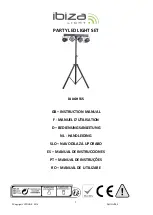
14
DMX-512 Background
DMX-512 is a digital data transmission standard developed by the United States Institute for Theater Technology
(USITT). It is designed to enable control of lighting equipment. DMX deals solely with the formatting of data for
transmission and does not dictate how the data is created or used.
Under DMX, signals are transmitted in much the same way a computer modem transmits data. The Data, divided
into channels, is "Framed" using a start bit, high (1), eight data bits and finally, two stop bits, both high (1). DMX
uses no parity to check the integrity of the signal. Instead, DMX relies on the ultra low probability of an error
occurring in the same place when the data is resent. The rate at which data is sent is fixed at 250k bps, almost
four and a half times faster that a 56k modem. This speed allows all data on a DMX chain to be updated more
than 44 times every second.
The transmitted data follows a specific format. DMX allows for 512 channels each with eight data bits, giving each
channel the possibility of 256 values. When a data "Packet" is sent, all channels are transmitted one after another.
Even if the data on a specific channel has not been changed, it must be sent. In a packet, a "start code" of all
zeros is sent before the data to identify the signal as a Standard DMX transmission. This start code is transparent
to the user and is handled by the controller.
The physical signals are transmitted using a twisted pair of wires and a common shield, a configuration called
Balanced. The controller and all receiving equipment are connected using a “Daisy Chain" connection. The signal
is jumped from the controller to a piece of DMX equipment. From there, the signal is jumped to the next piece of
equipment and so on until the last piece of equipment is connected. No branches are allowed and the signal does
not come back to the controller. The final piece of equipment will have only one cable connection. As a result, all
equipment connected to the chain will see exactly the same signal whether it is first or last. When connecting
equipment, no particular attention needs to be paid to the order in which the equipment is connected. Depending
on the conditions and equipment, a line terminator may be required. If there is any question, in most circumstances
the addition of a terminator will not degrade the signal. To make a terminator, attach a 120-ohm resistor between
the Signal Data Negative and Signal Data Positive pins of a connector in the last piece of equipment in the chain.
The DMX Standard uses 5 pin XLR connectors. However, it is common to see
fixtures with 3 pin XLR connectors as these types of balanced or “Lo-Z” cables
are common in the audio industry. In either case, pin numbers are the same
and carry the same signals.
Pin
Connection
1
Common (Shield)
2
Data Negative (S- or Cold)
3
Data Positive (S+ or Hot)
4
n/c (not used)
5
n/c (not used)
Содержание UltraLux DL-ULTRALUX7C6
Страница 15: ...15 ...
Страница 16: ...16 10900 Palmbay Drive Orlando FL 32824 U S A www techni lux com ...


































